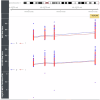Methylomic signature of current cannabis use in two first-episode psychosis cohorts
- PMID: 39406996
- PMCID: PMC11919776
- DOI: 10.1038/s41380-024-02689-0
Methylomic signature of current cannabis use in two first-episode psychosis cohorts
Abstract
The rising prevalence and legalisation of cannabis worldwide have underscored the need for a comprehensive understanding of its biological impact, particularly on mental health. Epigenetic mechanisms, specifically DNA methylation, have gained increasing recognition as vital factors in the interplay between risk factors and mental health. This study aimed to explore the effects of current cannabis use and high-potency cannabis on DNA methylation in two independent cohorts of individuals experiencing first-episode psychosis (FEP) compared to control subjects. The combined sample consisted of 682 participants (188 current cannabis users and 494 never users). DNA methylation profiles were generated on blood-derived DNA samples using the Illumina DNA methylation array platform. A meta-analysis across cohorts identified one CpG site (cg11669285) in the CAVIN1 gene that showed differential methylation with current cannabis use, surpassing the array-wide significance threshold, and independent of the tobacco-related epigenetic signature. Furthermore, a CpG site localised in the MCU gene (cg11669285) achieved array-wide significance in an analysis of the effect of high-potency (THC = > 10%) current cannabis use. Pathway and regional analyses identified cannabis-related epigenetic variation proximal to genes linked to immune and mitochondrial function, both of which are known to be influenced by cannabinoids. Interestingly, a model including an interaction term between cannabis use and FEP status identified two sites that were significantly associated with current cannabis use with a nominally significant interaction suggesting that FEP status might moderate how cannabis use affects DNA methylation. Overall, these findings contribute to our understanding of the epigenetic impact of current cannabis use and highlight potential molecular pathways affected by cannabis exposure.
© 2024. The Author(s).
Conflict of interest statement
Competing interests: The authors declare no competing interests.
Figures



References
-
- Volkow ND, Compton WM, Weiss SR. Adverse health effects of marijuana use. N Engl J Med. 2014;371:879. - PubMed
MeSH terms
LinkOut - more resources
Full Text Sources
Medical

